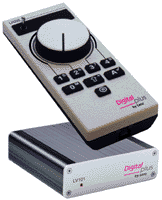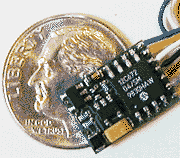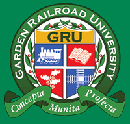

|

|
Power, Sound, R/C
:
Remote Control
An Introduction to DCC - Part 1
Feb 7, 2002


By Fred Hughes |
Author
Bio
Methods of powering trains in the Garden Railroad now include many options.
|

DCC Logo

Lenz Digital plus Set 02

Lenz LE010XF NMRA DCC Micro Decoder
|  | When most of us enter the world of Garden Railroading our first thoughts usually focus on prototypes, scenery, landscaping etc. which will allow us to build that dream layout. Many decisions have to be made. How much of the garden we are "allowed" to dedicate to the railroad is probably subject to on going "negotiation". Other considerations are easier. After the important decisions, far down the list is the method to power and control the layout. If we are running one train on our first loop then the control problems are few. As our dream layout expands to a few hundred feet of track new challenges emerge. Reverse loops, crossovers, turnouts, crossing guards, signals, merging lines are just a few of the features we may wish to include in our layout. |
Then we add more trains and it's seldom surprising when the "cornfield collision" about to take place is 200 feet away. We can't get there fast enough! As we add more trains our ability to enjoy a cold drink and converse with our garden visitors is made more difficult. In my case three trains started to stretch the limits. I'm not sure if it was the number of trains or the concentration required for on going conversations but in either case the collisions increased.
The old method of "DC block" control loses its appeal for our gardens because when using the traditional control panel approach we must remain tens or hundreds of feet from our equipment and we can't accompany our visitors in the garden. Additionally the logistics of a control panel in the garden is far different from indoors and presents increased difficulties.
Methods of powering trains in the Garden Railroad now include many options. Live Steam, Battery, Conventional DC Track Power and DCC. Methods of control range from Rheostats to Radio and Computers.
Because the scale of our trains is large one popular option in recent years has been the use of radio control devices combined with battery or track power. This approach has appealed to many of our fellow modelers for good reasons. Radio Control allows us to follow the trains as they traverse the garden. Battery power means we no longer have to keep the rails clean and we can either power the track to recharge the batteries or not. Both radio and battery have enhanced the enjoyment of operating trains in the garden and have continued to use traditional direct current DC to power our trains motors or charge our batteries.
The advantages of DC track power with radio control or battery power are obvious but these systems have limitations.
Good old-fashioned direct current (DC) track power in the garden has a major draw back. DC produces electrolysis because of its constant polarity. Just as automobiles tend to develop corrosion on one battery terminal so does DC power corrode rails and locomotive pick up wheels in the garden layout. Indoors this is less of a problem but the beauty of the garden comes with many enemies of DC track power. Pollen, moisture, dust, insects and more are attracted to the rails causing corrosion and reducing the ability of the locomotives to conduct power to the motors.
Radio control devices allow the engineer the freedom to control the layout without being tethered to a control panel allowing movement around the garden with the trains. However radio control with either track or battery power will not allow for automatic stopping at signals, throwing turnouts or convenient operation of other special effects.
About 24 years ago DCC began to enter the modeler's world. DCC is the acronym for Digital Command Control. Some of us never consider DCC because DCC must mean computers, complexity, and gosh knows what else. All we needed or wanted is a simple transformer. What was good enough for Dad is good enough for me. Here is the NEWS. DCC can be as simple as two wires to the rails or as sophisticated as our dreams will allow.
WHY CONSIDER DCC?
DCC to control and power trains offers significant advantages over conventional DC transformers. The following are just a few of the most obvious.
- DCC is an alternating type current that reduces electrolysis and therefore corrosion. Build up of corrosion on rails in the garden is substantially reduced using DCC compared to analog DC.
- With analog DC the speed and direction of trains is determined by increasing the voltage and polarity of the power supplied to the rails of a layout. This means when trains stop, smoke stops, lights dim and go out, sound ceases unless battery powered is provided. DCC provides a constant power, without regard to polarity, to the rails at all times regardless of the locomotive's speed or direction of travel. This means that even when stopped trains will continue to receive power and burn lights at the same intensity. Smoke generators will continue to operate. Sound systems will continue to function and batteries are not required.
- DCC allows one engineer to control many trains or many engineers to control their own trains limited only by the number of hand throttles available.
- The DCC industry has adopted standards recommended by the National Model Railroad Association (NMRA). The NMRA extensively tests all products that manufacturers submit for conformance approval before the manufacturer is allowed to display the "NMRA Conformance Warrant Symbol". This means that with the introduction of new products and accessories the investment made in DCC will not be lost. Products purchased from multiple manufacturers will be interchangeable.
- DCC equipped locomotives will operate on conventional DC layouts so we can still enjoy operating on other layouts without concern.
- Outdoor power leads can be reduced to 2 wires that provide power to the track and still control turnouts, reverse loops, signals and more.
These are a few advantages DCC offers but we need more answers.
- How does DCC work?
- What advantages might it offer to the Garden Railroader?
More next time...
Top of Page
|
|

|
IMPORTANT LINKS

Get Your Official Diploma

Watch New Videos


New Products Online
|
|



